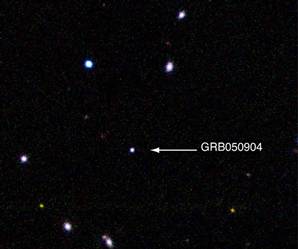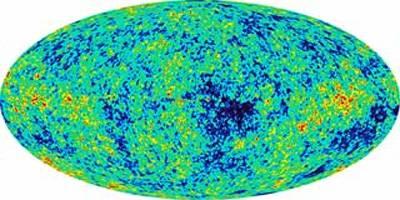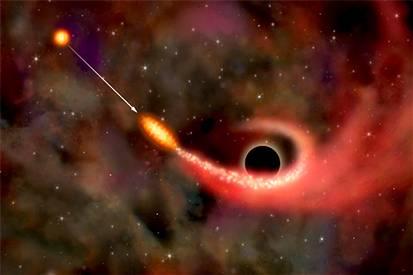|
Most Intense Energy Burst
In
Our Galaxy
Hits Earth!

A NASA artist's illustration of the brightest blast ever to be detected in our Milky Way Galaxy.
February 18, 2005. NASA reports that our upper atmosphere was struck by a gigantic blast of X-ray energy in December that was
so powerful that it actually altered the ionosphere (an upper region of our atmosphere) for a short time. (That's a region
around 50 miles high that produces turbulent energy and helps to protect us down below.)
What made this event so spectacular is the fact that the flash came to
us from a location on the other side of our galaxy that is approx. 50,000 light-years away. That means that the energy blast
took approx. 50,000 years to reach us!
That is a long way for a burst of energy to travel and yet end up as the
most powerful blast of its type ever to hit our planet and be detected by human beings. And it is estimated, by Rob Fender
of Southampton University in the UK, to have released more energy in one tenth of a second than our sun emits in 100,000 years!
Where did all that energy come from, you may ask? Well, it came to us
courtesy of a neutron star that is only around 12 miles across. Yet, in spite of its size, it created a blast that was observed
to be at least 100 times as powerful as any other explosion of its kind ever observed from Earth.
We are fortunate that there are no neutron stars of that type anywhere
near our own galactic neighborhood.
NOW SEE WHAT FOLLOWS
New Distant Gamma-ray Burst breaks the above record by 500 million light-years!

VLT/ESO Image of the explosion.
Sept. 12, 2005. This
latest blast is the farthest known; the farthest ever detected. Explosions of this nature are believed to be from very massive
stars that have collapsed into black holes and represent the most massive explosive events that Humankind has ever detected.
The only thing believed to be more massive in power would be the original Big Bang.
It has taken so long for the energy wave to reach us that it had had to
have started when the Universe was less than 1 billion year old. This makes it one of the oldest objects ever detected.
Hubble Space Telescope Finds Most-Distant Supernova at Over 10 billion Light-Years
From Earth!
And, it opens all sorts
of new possibilities and ideas about our Universe.

The "Discovery Channel" (TV), Discovery.com, and the Associated Press have announced (near
the turn of the century) the Hubble Space Telescope finding of a supernova whose light has only just now reached us from
its starting time of over 10 billion years ago!
It now stands as the most distant exploding
star that has ever been observed from Earth! The image comes to us from a time when the Universe was only about one quarter
of its current age.
The initial report states that,
"Researchers said the discovery bolsters the controversial theory that mysterious 'dark energy' is accelerating the expansion
of the cosmos."
It further noted that, "Invisible
and poorly understood, 'dark energy' might account for as much as two-thirds of space. Proposed a century ago by Einstein,
it may counteract more familiar forces such as gravity."
Most cosmologists seem to feel that
the Universe began in a sudden expansion, from a tiny cosmic singularity, anywhere from 12 billion to 15 billion years ago.
Then gravity began slowing down that early expansion. And then, about 4 billion to 8 billion years ago, the Universe began
to accelerate its expansion once again. They're not entirely sure why, but they suspect that the 'dark energy' may have then
become the dominant factor.
It is felt by many in the field, that
the brightness of this new supernova, as related to its distance, suggests that this acceleration may truly be happening.
Of course it was also noted by some
that, "Alternative theories suggest that dust in the universe was not as dense 10 billion years ago, making the dying star
appear brighter than expected." And there are those of us who are inclined to suggest that 'space' itself may be a dominant,
physical presence that is the true fabric (or 'quantum foam') of space, the primary structure of the Universe and responsible
for the expansions of space that we observe.
What we do know, for sure, is that,
at this time, we don't absolutely know much of anything about such things. We have just gotten a peek through a crack in the
cosmic door of the Universe. Now we'll have to try and figure out what we think we can almost see.
The Size Of Our Universe
Has Been Upgraded

Probe image courtesy of NASA.
Thanks to the Wilkinson Microwave Anisotropy Probe (which shows temperature
differences in the cosmic radiation echo believed to be left over from the Big Bang) scientists have now been able to offer
a new estimate that puts the width of our known Universe at approx. 156 billion light years. (That's about 6 with 12 zeros
after it, in miles per light year.) This is considerably larger than previous estimates.Since the Universe is considered to be around 13.7 billion years old, one might assume that, since the
earliest light to reach us started just about that long ago, the Universe would be around 13.7 billion light years wide. Not
so.
Since the Universe has been expanding from the beginning of time, the distances are
therefore increasing. This increase has been estimated and the more accurate total distance calculated. And the total is around
156 billion light years (and growing).
Does that mean that the galaxies are rushing away from one another? No. It means
that the amount of space between all things is increasing. And, we are told, this increase is a notable acceleration. What
else that may mean, we really aren't sure. But then, we're not too sure about much of anything.
We are only at the very beginning of rudimentary understanding.
The Universe
As We Know It Now
(2009)

Illustration courtesy of NASA.
The deeper we look into space, the further back into time we see. That is because the light travels
at approx. 186 thousand miles per second. (That's 6 with 12 zeros after it, in miles per year.)
So, when we are looking at light images that are very far
away, we are seeing how things looked in that place when that light first started its trip to our telescope. Some of those
places are so very, very far away that the light was first emitted many thousands of years ago (and sometimes millions of
years ago, and sometimes billions of years ago).
That means that our telescopes are visual time machines that actually allow us
to look back in time to those earlier periods. Of course we have not yet managed to reach the beginning (the big bang) but
we are getting closer and closer.
Then, after that, what might we find? Who knows. That is one of the great mysteries
of the Universe.
More Confirmation of Dark Matter?

NASA/STScI
These are Hubble images of three of the most distant supernovae known. By tracking these exploding
stars, astronomers can trace the expansion rate of the universe and determine how it is affected by "dark matter."
A Closer Look At Space
Observations
strongly suggest a strange, repulsive dark force dominating the whole universe. It may prove to be the primary element of
space itself, and it’s accelerating the recession of the galaxies away from each other, faster and faster.
It is theorized that around 70 percent of our universe may be made up of
this "dark energy." And most of what’s left is being called "dark matter." The very tiny amount of what remains is what
we are familiar with, galaxies of suns, visible energy, planets, and you and me.
Adam Riess of the Space Telescope Science Institute has been quoted as saying
that, "We still have almost no clue what it is." It is called "dark energy" and "dark matter" because, even though we notice
what we feel are the effects of this mysterious force and unknown material, we are unable to see it.
Various scientists suggest it might be something that percolates out from
empty space. Others theorize that it could relate to what is thought might be a changing energy field similar to a magnetic
field. This has been labeled the "quintessence" field. Actually, putting a label on it doesn’t mean it definitely exists.
Of course some think it might and a label is a helpful identifier to better facilitate the investigation. But no one really
knows for sure what we really have here.
This writer feels there is a growing body of observed manifestations and
theoretical suggestions that seem to show, as seen in the "space change/time" concept, that space itself is the primary existence
and that the various movements therein create the effects of the passage of time by the space changes between the pock mark
anomalies we recognize as matter and energy, which are also detected as such movements.
In other words, the whole universe does seem to be endless changes in spacial
measurements of what we observe as space itself. What seems very strange to us is that this is all we find that there is.
All attempts to identify anything, in its fundamental form, shows us only movement of particles and energy, which are seen
and measured as changes in the volume of space itself.
Even in the muddy waters of "string theory," we assume vibrations and undulations
in the string-like form. There seems to be no escaping this, until such a time as we might somehow manage to find something
other than the changes in the volume of space.
Thus, we can see it just might be that the unseen "dark" matter and energy
of space is really what space itself is, for after all, how would it be possible for space to be fluctuating if there is nothing
there to fluctuate? Does it not have to be "something" to behave in such a manner?
And what is this "something" that is space? We really don’t know. It
could be an entirely different dimensional structure than what we know of. It most certainly is well beyond our current ability
to fathom. It is the great, new mystery. It is the great unknown.
So, it would seem that the more we discover, the more we come to realize
that nothing is anywhere near what we think it is. And what we seem to be finding is so bizarre as to be unacceptable to most
of us, in or out of the space sciences. We can only lurch about, timidly poking at this and that and trying ever so hard to
see, to really see what it’s all about. If nothing else, it most certainly is a very humbling experience.
We're Learning About
The Black Hole
in The Core
of Our Milky Way Galaxy

Sagittarius A (Hubble image - NASA)
Above is the image of the "Event Horizon" and
the further surrounding area at the core of our Milky Way galaxy where the NASA Chandra X-ray observations identify a supermassive
black hole that we have found to be subject to frequent explosive outbursts.
This was announced by the American Astronomical Society after 164 hours of detailed observation.
The area can be found in the constellation Sagittarius, which is in the region of the center of our "pinwheel" galaxy.
This discovery is yet another example of our sometimes very violent universe. (Not unlike human behavior on the planet
Earth.)
Another Violent Event
in Our Universe

NASA/CXC/M.Weiss illustration.
A black hole is believed to have been discovered that seems to be ripping
apart a star that made the mistake of wandering too close. It has been a visually exciting time in the RX J1242-11 System
as some of the material from the unfortunate star is sucked into the massive black hole while most of it is thrown out and
around the surrounding galaxy. (The star was totally ripped apart in just a few short days.)
This is happening at a point that is around 700 million light-years away.
Yes, you need not seek shelter under your bed. A "light year" is the distance light travels in one year. That's approx. 6
with 12 zeros after it, in number of miles. That is a long way to go and a long time ago. But, it does make a great show for
us here and now.
|

